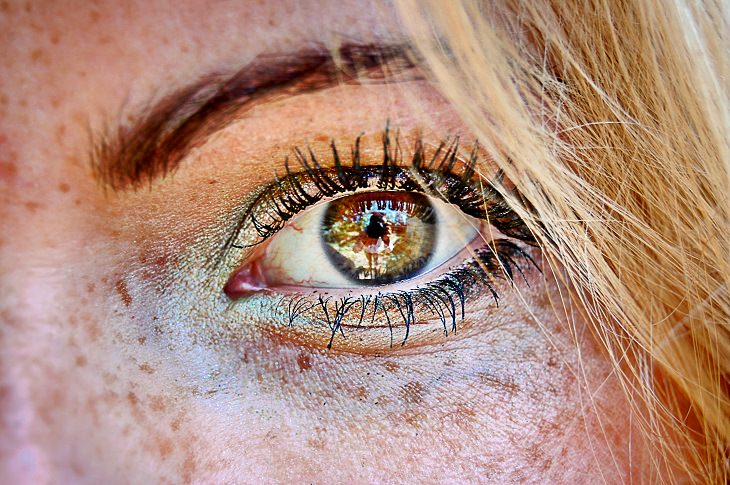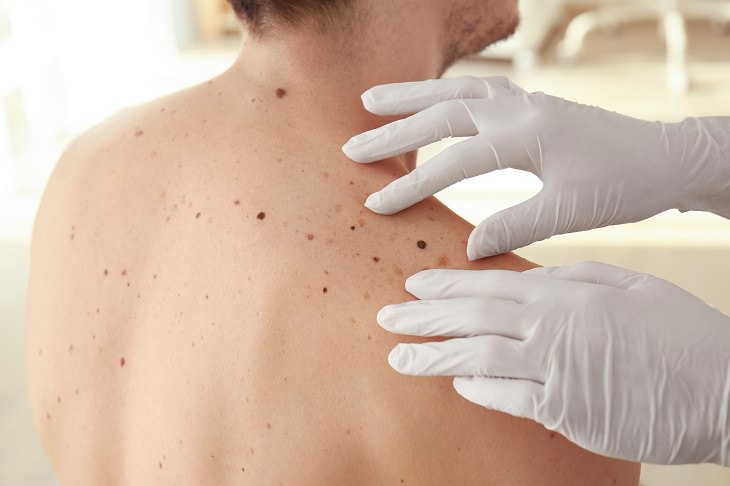It’s easy to spot weird moles and spots on
your face, but according to statistics, the most commonly affected areas
are the back in men and on the legs in women. Doctors advise paying
close attention to areas where moles come in contact with clothes or
shoes due to a higher risk of injury.
With every sunburn, especially the ones that you got in early childhood,
the potential for the development of melanoma increases. Furthermore,
if a member of your immediate family has had melanoma, you have a higher
risk of getting it.
2. A Particular Danger is Posed by Big,
Dark, and Raised Moles
During the early stages, a malignant tumor looks like a normal mole. If
you have more than 50 moles on your whole body, then it’s a good idea to
get them all examined by an oncologist and a dermatologist. Blue-eyed,
light-skinned, red-haired, and freckle-faced people are in the high-risk
group.
Dark spots that look like little moles on an eyeball are a cause for
concern and require an ophthalmologist examination. In the majority of
cases, they’re harmless, but some can be a sign of malignant eye damage.
3. Only Cancerous Moles should be Removed
Doctors can remove any mole if it’s
physically uncomfortable or aesthetically displeasing. For example, if
you think that you might injure it accidentally or that it doesn’t look
good on your face, go and have it removed.
4. Getting a Mole Removed with a Scalpel is an Outdated Practice
A scalpel is the most effective way to remove a mole. This is because a
scalpel is able to remove a mole completely, eradicating the threat of
any cancerous cells spreading. The removed mole is then sent for a
histological examination to see if it contains cancerous cells. If it
does, treatment will begin immediately.
However, when it comes to the ears, face, fingers, or genitals, doctors
recommend radio-frequency surgery.
5. Some People Have a Lot of Freckles from Birth. You Don’t Have to worry about It

There is a dysplastic nevus syndrome which
is characterized by multiple moles and freckles on the body. Every
single mole has the potential to turn into malicious melanoma.
Therefore, people with such a skin condition should check their skin
using a dermascope – which takes photos of the skin and traces the
appearance of new moles.
People with freckles are vulnerable to UV rays. Freckles don’t contain
much melanin, which is why they are paler than moles. Therefore, people
with freckles should use sunscreen with a protective factor of 35 or
more when out in the sun.
6. Dark-Skinned People don’t Need Sunscreen
People with darker skin do have more protection from UV rays, but
they’re still a long way away from African elephants, whose thick skin
and special genes make them impervious to harmful rays. This is why
dark-skinned people still need to use sunscreen, put on headwear, and
avoid going out in the midday sun.
7. If You Injure a Mole It Should Be Removed
Firstly, if you injure a mole, you need to
get it cleaned up to avoid contamination. Then, after it’s been cleaned,
apply an ointment that helps with tissue regeneration. After that,
schedule an appointment with an oncologist and dermatologist as quickly
as possible.
Injuring a mole doesn’t necessarily mean that it has to be removed.
However, very often, inner pathological processes make it very
vulnerable to further injuries. A doctor’s examination can help to
eliminate the risk of melanoma developing.
8. If You Rip a Mole Off, You’ll Get Cancer
There’s no clear evidence that this can lead to melanoma. Very often, an
injured mole that turns out to be a melanoma was already cancerous.
If a mole is bleeding, it doesn’t necessarily mean that you have caught
it somehow. Pathological processes inside a mole can also cause
bleeding. This is a very dangerous symptom that shouldn’t be ignored.
This is only for your information, kindly take the advice of your doctor for medicines, exercises and so on.
https://gscrochetdesigns.blogspot.com. one can see my crochet creations
https://gseasyrecipes.blogspot.com. feel free to view for easy, simple and healthy recipes
https://kneereplacement-stickclub.blogspot.com. for info on knee replacement
https://cancersupportindia.blogspot.com for infor on cancer and health related topics
https://GSiyers
home remedies.blogspot.com is the latest addition to my blogs. I'm
going to add posts there, do give me your valuable feed back on my
blogs. Thanks a lot, take care, be healthy and be happy.



0 Comments:
Post a Comment
<< Home